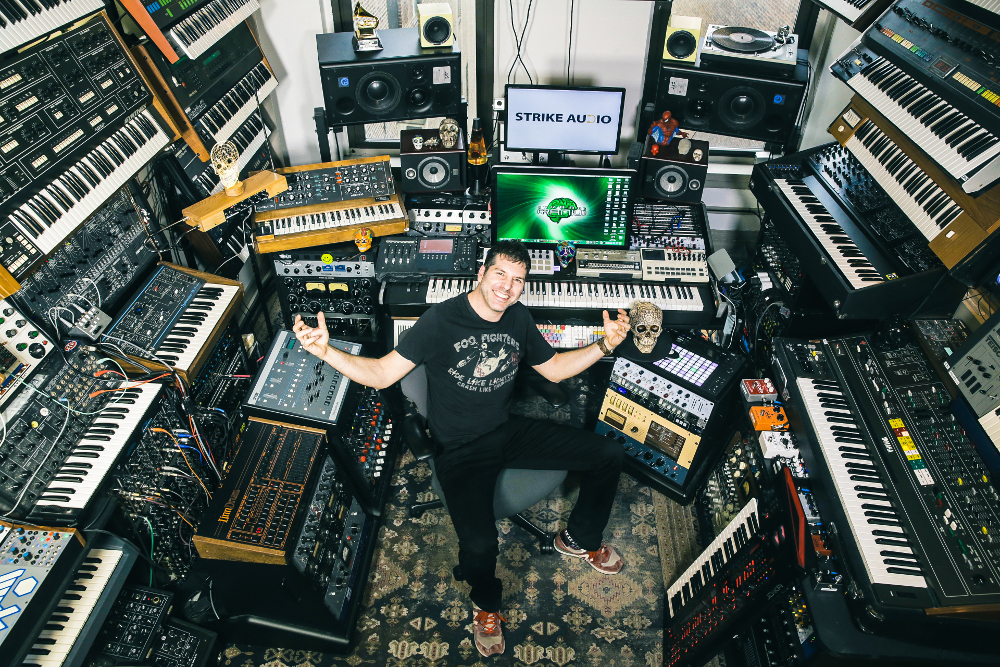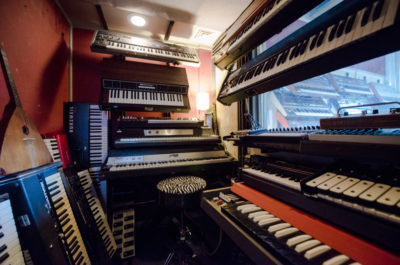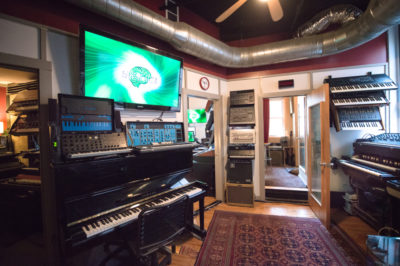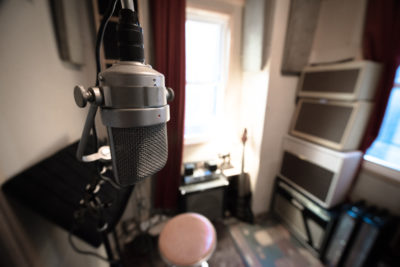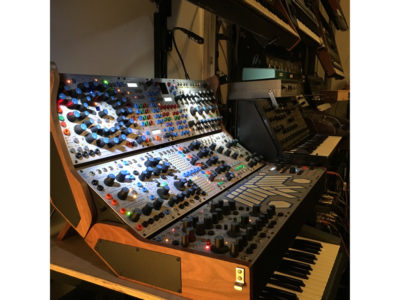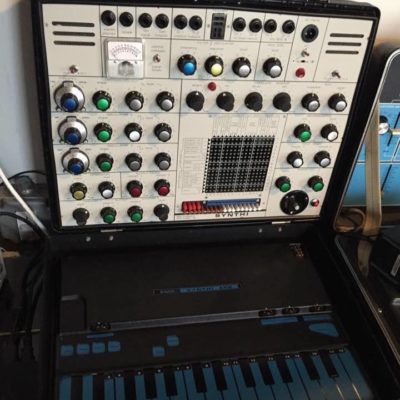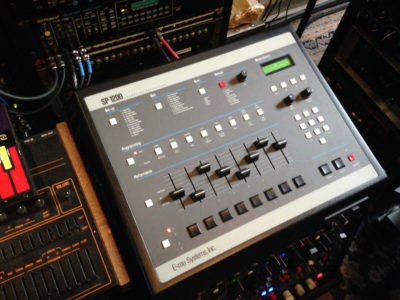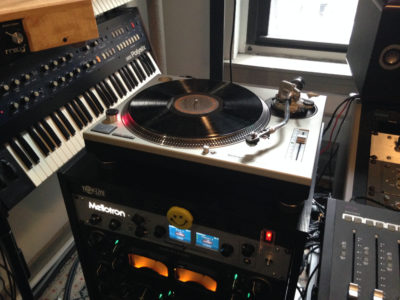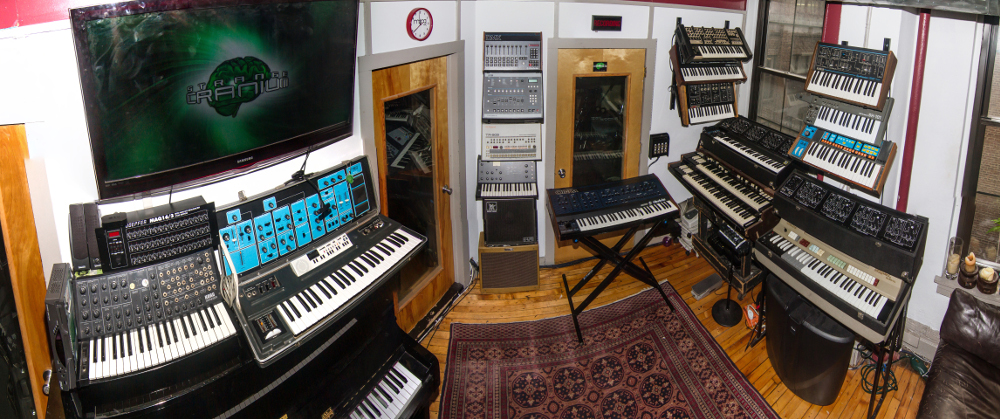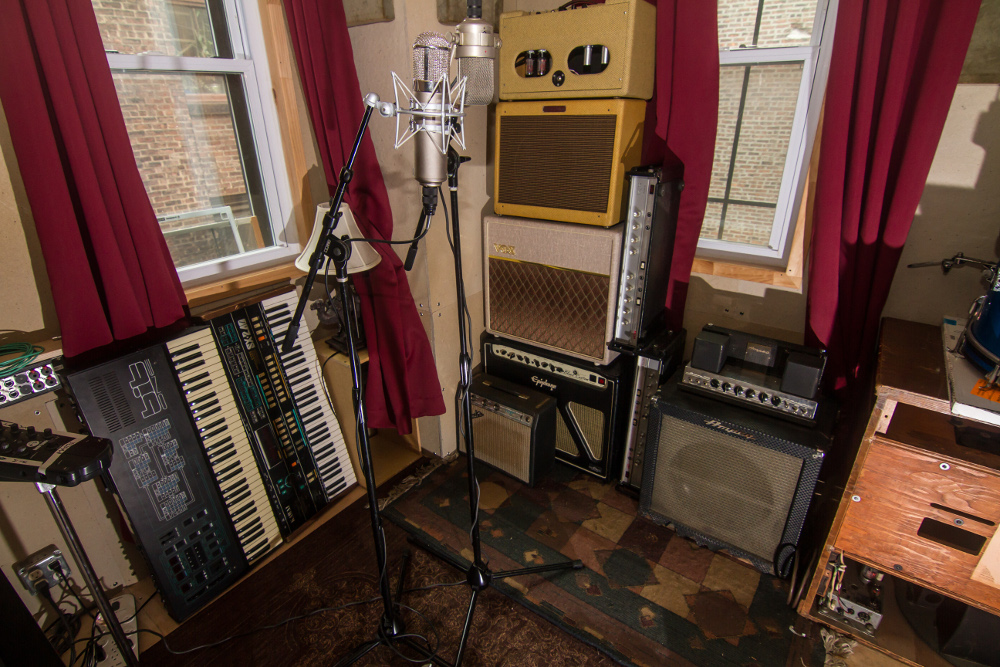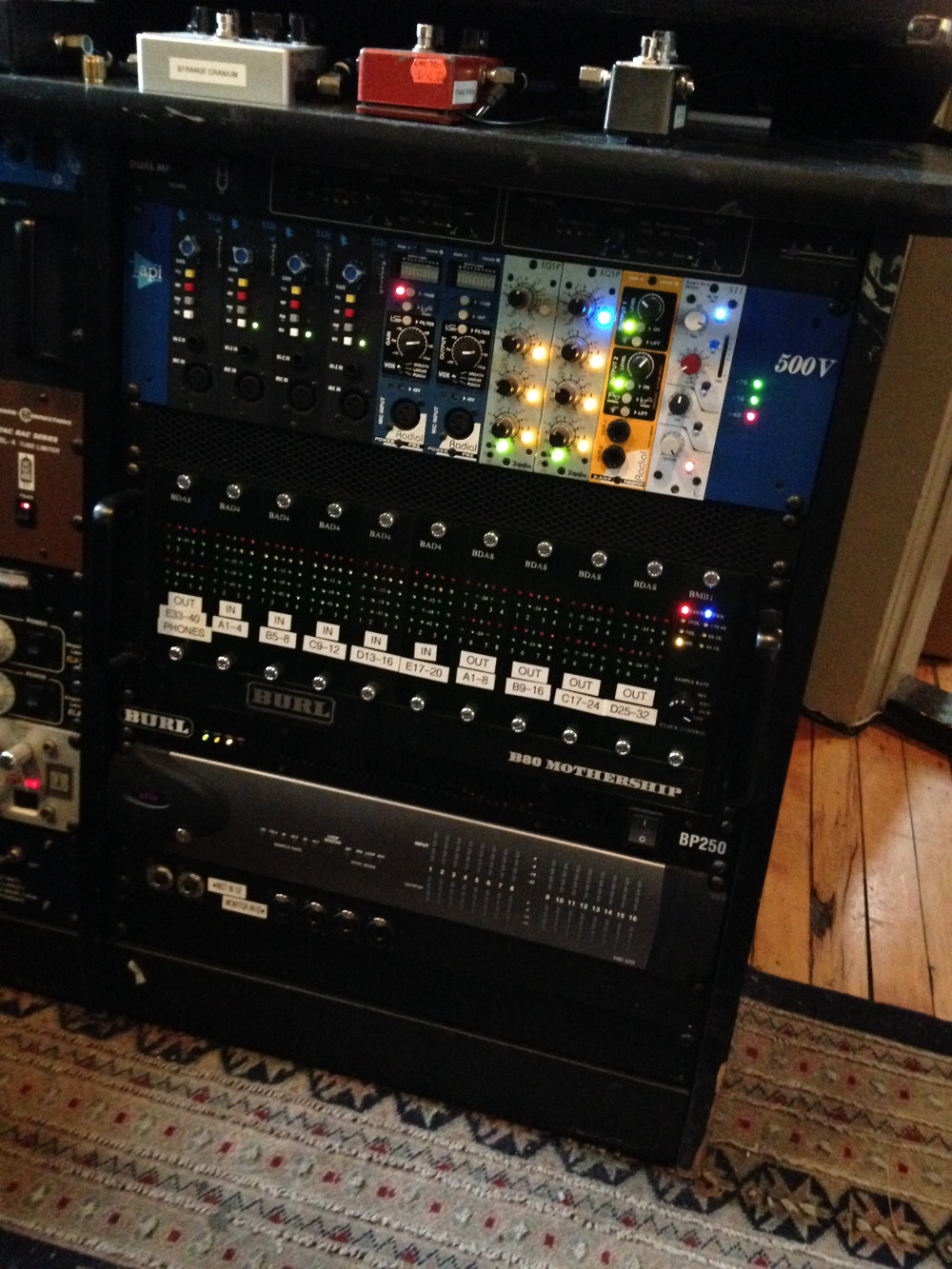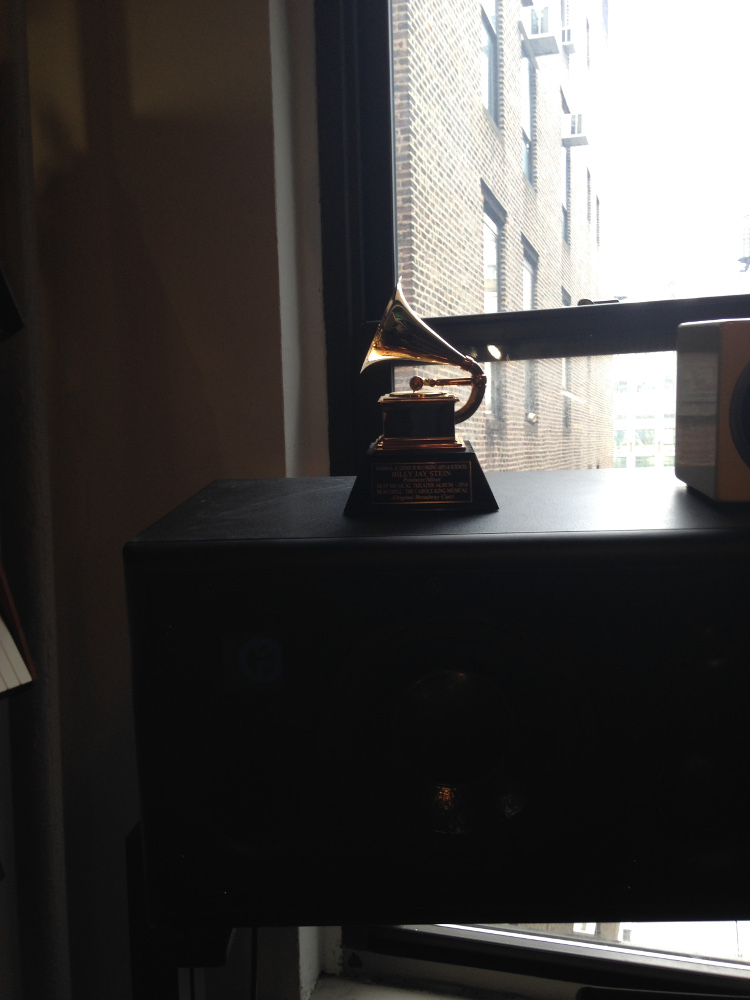Composer Cribs: Strike Audio — Flatiron District, Manhattan
Ready for anything. When you’re a music house maintaining a four-room studio in the heart of Manhattan, occupying a narrow niche is not an option.
Hence the military mindset evoked by the name Strike Audio, a facility like none other in NYC – and quite possibly the world – that’s poised to make just about any kind of music. HQ’d in Manhattan’s Flatiron District, it’s the creative home of Billy Jay Stein, a composer with a degree in neuroscience that just can’t get synths out of his system.
If you’re lucky enough to get invited inside Strike Audio, which is both a full-service music house (Strange Cranium Productions) and a production music library that’s 20,000 cuts strong, prepare your senses to be overwhelmed. More than 100 keyboards and drum machines – vintage to ultramodern – populate the space, with 35 instruments at the ready in the fantastic main control room.
Trained early in his career to write faster/better/more, Stein has a smart strategy for applying every resource at hand into his workflow. That’s right: The whole beast is killed and eaten here, all in the name of GRAMMY-winning projects (in 2015 for Beautiful: The Carole King Musical), the Olympics, VICE, “Duck Dynasty,” and countless other TV and film projects.
Stein has a (not-so) secret weapon to keep him in peak form – a mod master that keeps all his synths not just up and running, but also assures that even the most vintage ones are on the cutting edge. It’s a key to how new sounds, and fresh ways to make them, are constantly being invented at Strike Audio.
The best news of all? It’s not just Stein who’s privy to this garden of synthetic delights. Others have access too, including musical artists and other composers. Even if you’re on the other side of the world, there’s a way for you to take advantage of this incredible collection of sound sources. Read on to become one with this highly inspired sonic fighting force…
Composer Name: BILLY JAY STEIN
Website: http://www.strikeaudio.com and http://www.strangecranium.com
Location: Flatiron District, Manhattan, NYC
Soundtracks Served: Television series, Advertising, Film, Artists, Musicals.
Clients/Credits: Some of my credits include: the 2015 Grammy Award for Best Musical Theatre Album for producing and mixing Beautiful: The Carole King Musical. Music producer, co-arranger and co-composer for the Radio City New York Summer Spectacular featuring the Rockettes, which opened in June 2016. Composer for the original score for the feature film, Sister, an Official Selection at the 2014 Tribeca Film Festival, and Composer for “Sex and The City”, “2016 Olympics,” “Pawn Stars,” “Vice,” “Duck Dynasty,” “Catfish,” “Love and Hip Hop.” I have also played keyboards with Ray Charles, Darlene Love, Warren Haynes, and Collective Soul.
Currently, I’m writing and producing a collection of pop songs with Ann-Marie Milazzo for the Strike Audio music library.
For Example…
External Inspiration: I have gotten a tremendous amount of inspiration and knowledge from the many composers and artists from all different genres of music I have worked with over the years. They have included Bono and The Edge, Carly Simon, Jeanine Tesori, Carole King, Jason Howland, Frank Wildhorn, and Jule Styne, among many others.
When composing or producing, even under enormous pressure, it’s imperative that the atmosphere stays relaxed and open – and that’s how they do it. Also, just to be able to collaborate with such naturally gifted artists inspired me to push to myself even harder in all aspects of my work.
Synth Fix: The Synthesizer is a machine that combines both music creation and scientific exploration.
I’ve loved music and science since I was a little kid — I began my piano training at an early age as a private student of the world-renowned concert pianist, Edward Edson. After saving up money from my paper route, I bought my first synth at the age of 11, the Moog Source. In junior high school, I created a mini recording studio in my bedroom; a Korg Polysix keyboard, a small TAMA drum set, a Mackie board, Radio Shack mics, and two Sanyo tape decks rigged together to create multi-track mixes. I used this equipment to record my own songs and the songs written by my rock band in high school. I became involved in all aspects of the recording process: composition, production, engineering, mixing. I loved it!
When I was a freshman studying Neuroscience and Music at the University of Pennsylvania, I joined the rock & roll band, The Hatters. We built a huge following of college students and ultimately got a recording contract with Atlantic Records, releasing three albums. After graduation in 1991, we jumped on a bus and spent five years on the road, living in the mountains of Nederland, Colorado during breaks.
I toured with a Hammond B3, Rhodes Mark I, Wurlizter 200A , Octave Cat mono synth, the trusty old Moog Source, Clavinet D6, and a Korg SG1D with lot of FX pedals. The Hatters toured about 300 days a year and had the opportunity to share stages with the likes of Dave Matthews, Sheryl Crow, Buddy Guy, Blues Traveler, Collective Soul, the Allman Brothers, King Sunny Ade, Jimmy Cliff, and A Tribe Called Quest.
After we broke up in 1996, I moved to NYC, and added more gear to my collection, including a Roland X7 keyboard workstation, a couple of Akai samplers, Emagic Logic, Sony ACID, and GigaStudio, and started my first music company, STRANGE CRANIUM, (a nod to my neuroscience degree) in my apartment. I never stopped reading manuals and studying the ins and outs of synthesis.
In 1996, I met Michael Rosen, an accomplished television producer and songwriter, while I was writing music for VH1. Michael was an executive at the channel and he pushed me to write better, faster and more. We had collaborated on several of his television series and realized that by combining our expertise, experience, and insight, we could create a very user-friendly, world-class catalogue. In 2006 we formed STRIKE AUDIO.
Fast forward to today and my current NYC studio setup is quite a bit larger and I have one of the premier synthesizer collections in the world. But this is not purely a collection to stand back and admire. This is a working, living, breathing collection. It is simply the evolution of that small childhood bedroom setup from the 1980s. I still feel like that 12-year-old kid when I come in to work every day!
The Business: My company, Strike Audio, is an exclusive production library of over 20,000 cues composed specifically for television, film, and advertising. Co-founder Michael Rosen and I currently have 15 composers working full time and many others who submit music to us on a part time basis.
All our cues come with alt. mixes/stems and stings so our music can easily be manipulated by editors who demand that sort of flexibility from a music library. To date, our music has been featured on over 6000 episodes of television, and we are in constant contact with showrunners and production companies that we have collaborated with for many years. They’ve come to trust our ability to produce music in almost every genre imaginable and to stay very relevant in the ever-evolving music world.
Big Premiere: Strange Cranium has been around for more than 20 years. Strike Audio was founded approximately 10 years ago, and I have been in the current studio location for about 8 years.
Room Inspiration: Located in the Manhattan’s Flatiron District, Strange Cranium/Strike Audio Studios has an unparalleled array of working vintage and state of the art instruments and recording equipment.
Our studio has a Large Live room with 14 foot ceilings, Large Vocal/ISO booth, Small B room editing facility, and a large Control Room with a fantastic view of the Empire State Building. I wanted to have light in the space and this studio has tons of light via large windows in every room. The focus of my space is creativity and composition. All of my over 100 unique keyboards and drum machines are wired up to the patchbay and are at arms length, ready to play when inspiration hits! Most of the gear has even been retrofitted with MIDI and connected to Pro Tools via several MIDI interfaces placed around the studio. The 1,000 square foot space is divided into four rooms.
The front area houses two complete music editing/SoundMiner setups. This is where data cataloguing of the Strike music library takes place. This is also where Hiro Iida, my partner on Broadway theatrical synth programming projects, works on cutting-edge software sounds and beta-tests music software programs. He also oversees the building of the many MainStage rigs for my Strange Cranium Music Rental Division. He is an amazing synthesist, who has taught Electronic Music at Berkeley. We are constantly working together on various Electronic Music Design projects and have several major shows running our systems. They include Amelie on Broadway, Beautiful productions in NYC and London, and The King & I and Fun Home National Tours.
The large live room is a great sounding drum room, also used to record larger vocal groups. This room holds some of the bigger keyboards such as The Hammond B3, Yamaha Upright Piano with MIDI, Oberheim 8 voice monster one-of-a kind synth, Fasfisa, and Vox Continental.
The Studio B room editing facility contains another ProTools rig with a UAD Apollo 16 interface, and most of my electro-mechanical synths like the Rhodes, Wurlizter, and Clavinet. These are also connected to main Pro Tools rig in the other room via patch panels.
The Vocal Booth is relatively large and is where my all my amps, both modern and vintage, reside. I also have a beautiful collection of microphones. As Linda Eder’s music director, arranger and producer, I searched far and wide for the prefect microphone for her. She is considered one the greatest vocalists of our time, so finding the right mic was extremely important. I settled on a 1958 Neumann M49, and wow does it sound great!
Last but not least, there is the Main Control Room. This is where I live the most. It centers around a Pro Tools rig with a Burl Mothership fully fitted with 40 outs and 20 ins. I am a big fan of analog, so I have a NEVE 5060 centerpiece with a Neve satellite 5059 as my summing solution. I have tons of vintage outboard FX such as: The Publison Infernal Machine 90, Publison DHM89 B2 delay/pitch shifter, AMS Dmx15 delay, Eventide SP2016, Binson Echorec 603-T, some Roland Tape Echos, and old Panasonic Spring Reverbs, a really cool old Schaller Spring Verb, Mutronics Mutator, some Eventide Harmonizers, Bricasti M7, and more.
My compressors include the Shadow Hills Mastering Compressor, Orban Optimod 8100, Smart C2, Neve MBP, Obsidian, Inward Connections Vac Rac, Retro Sta-level, Distressors, and a couple of Retro 176s, a bunch of vintage 1176s and La3s. For EQ, I love the flavors of the GML8000, Manley Massive Passive, EMI curve bender, 2A3 program eq, Dangerous Bax Eq, and some Vintage Pultecs… As far as preamps, I have some Neve1073s, APIs and racked SSL preamps.
The Current Collection: All the synths and drum machines I own have a distinct character and heritage.
A few of my favorite synths include a one-of-kind black Oberheim 8 voice, that Tom Oberheim told me is one of six working still left on the planet. This beast was owned by the late Stephen St. Croix, the developer of the Marshall Time Modulator and one-time editor of MIX magazine. He had it modded to receive eight channels of CV back in the day, so I found a couple of old Roland MPU-101 interfaces, and now I can control the synth with MIDI!
I also have another unit of St. Croix’s which is an ARP 2600, supposedly used by Stevie Wonder on “I Wish” from Songs in the Key of Life. Another favorite synth of mine is a mint Yamaha CS80 that was played for years by Bill Payne, from Little Feat. Bill brilliantly removed the power supply from the unit and attached it outside, so the internal oscillators remain cool and stable. I also had MIDI installed on it and this has got to be one of the best sounding and functioning Yamaha CS80s in the world. I also have a large Buchla Modular System, which is an amazing instrument, great for sound design and inspiring otherworldly pads and sequences. And lastly, I love my rare 1982 ELKA SYNTHEX polyphonic synth, which has the most beautiful, and lush string pads ever.
Two a Day: It is easy to get lost and wrapped up in all the sound possibilities of the incredible instruments here. Just like with modern day Pro Tools, there is an infinite amount of tracks/sounds at your fingertips with all these incredible synths.
I find that if I limit myself to two keyboards a day, it gives me a constraint and challenge to focus on music creation and to dig deeper into the specific and unique sound parameters of the particular instrument. Sometimes I will combine two completely different eras and concepts (like an FM synthesis-based TX-802 and an additive synth-based Kawai K5000s), or simply focus on piano and organ.
Key Personnel: From day one, Strike Audio has always been a very, very composer-friendly company. It’s something we take great pride in. Our composers are our partners, and most of our team has been working with us for many years. They are world-class musicians and producers. If you count all the great talent that have worked with over the years, it’s essentially a who’s-who of the music industry.
Mod Master: Takeshi Kawana is truly the Mod Master. He came to NYC in the late 1980’s after working as the main technician in Roland Japan. He has been working here at Strange Cranium for several years now. Because I have so many vintage (and therefore old and fragile) instruments here, having a guru like Takeshi is integral to the survival of this studio. I want to use the synth collection daily, not just let them sit there. Takeshi constantly fixes, maintains and upgrades my gear. The studio has become a living, breathing museum so to speak.
Here are some of the amazing and unique things Takeshi has done for me:
I have been working with composer Nick Littlemore (Empire Of The Sun) over the years, and he mentioned he wanted to push the boundaries of composition. We had Takeshi modify a rare 1972 TRIADEX MUSE to transmit CV, in order to control and manipulate other synths in the studio. The Muse is an algorithmic, deterministic event generator. It utilizes very early digital integrated circuits to generate audio sequences via four parameters and sliders that “randomly” send data as you move them. With Takeshi’s mod, we are now able to create unique music that is completely fresh and retro at the same time.
Another really cool thing that Takeshi did at my request was to build an interface that would allow me to control my EMS Synthi via MIDI. The Synthi has an attached keyboard interface that allows you to play sequences, ala “On The Run” from Pink Floyd. This is totally fun and quirky to use, however I challenged Takeshi to create something that would allow me to control the synth with modern technology. He created an interface that allows the Synthi to be slaved to sequences in Ableton Live, and be modified by an external LFO from other sources like my Buchla Dual Arbitrary Function Generator and my Moog Modular.
Lastly, Takeshi created a way to control my Arp Quadra with MIDI. I am pretty sure I have the only MIDI-controlled Arp Quadra in the world!
Workflow Requirements: Besides being a composer and arranger, I also am a producer, mixing engineer, and session musician, so I needed to create a space that would enable me to do all these different tasks easily. I tend to switch my musical hats several times during the course of a day.
My furniture solution is the Sterling Modular Multi-Station 3 Bay Composer Desk. My main 88 key controller, the Yamaha SX90, is at perfect playing height, and I am also sitting in the prime mixing position. ATC SCM50ASL Pro speakers are on large stands on opposite sides of the desk and the ATC sub is under the desk for monitoring. I also check mixes on Focal Solos and Auratones on the stands attached to the desk.
I built video monitor arms to allow me to have three video monitors at good viewing angles. In just the main control room alone, I have about 35 keyboards and drum machines at arms length, all plugged in and MIDI’d up, ready to go. I use LM Standtastic wall mounted rack stands to hold all the synths.
The other two tracking rooms are around me in a semi-circular fashion. These have direct sight lines to my main position and to each other. Great for tracking.
Of course I use and love my analog synths, but I also love soft synths and plug-ins. I particularly love the reFX Nexus synths, the Spectrasonics libraries, the UVI libraries, and Native Instruments stuff. As a synth programmer and designer for several Broadway shows, I have to stay up to date on the latest and greatest developments in the computing world. I use Mainstage for theatrical productions.
Over the years I have translated my GIGA and EXS libraries to Kontakt use Chicken Systems Translator. Kontakt is now my plugin for my custom-made sample instruments as well.
Another key piece of software I use is Vienna Ensemble Pro. This is a host for all my software plug-ins and custom instruments. When I do orchestral mock-ups, as I did recently for the Radio City Rockettes NY Spectactular show, VE PRO allows me to host my large Orchestral libraries on many outside computers (three Macbook Pros and three Mac Minis), and my system can handle hundreds of tracks.
Audacious Analog Outboard: As I mentioned earlier I love my analog outboard gear. Each unit has a distinctive sound and character.
I am still searching for the best master bus chain, which I put at the end of all my mixes. My current flow is NEVE Master Bus Processor- Manley Massive Passive- EMI Curve Bender- Dramastic Audio Obsidian- Dangerous Bax Eq- Shadow Hills Mastering Compressor. I play around with the master bus all the time depending on the program material.
For vocals, my secret weapon is the Publison DHM89 B2. I use it to thicken/detune/shimmer/loop vocals, it sounds like NOTHING ELSE on earth. Incredible. I also love running my synths through some cool guitar pedals and amps. I have the Radial X-AMP ReAmp 500 series module and Little Labs PCP Instrument Distro Splitter to help facilitate this.
Picture This: I simply use Pro Tools! It works flawlessly.
After Hours: The studio is busy all day and evening. At any given moment we are working on a TV series, creating sounds and loops for theatrical productions, tracking vocals and/or overdubbing synths. That said, I love sharing the room with young talented artists at night, who appreciate the cool gear here. For instance, just last week the amazing singer/songwriter COBI came by after performing on Jimmy Fallon, and he worked on some new music.
Also, because most of the gear has been retrofitted with MIDI, folks send me their MIDI files and I can run the “real things” for them. Soft synths are great, but the old analog synths have something special you cant recreate (yet!).
Live Guy: I am currently the Music Director and pianist for Linda Eder. We have about 40 concerts a year. Playing with other people is amazing, stimulating and therapeutic. We typically go out in small quintets, but at least 10 times a year, we perform with choirs and with orchestras. Just recently we played with the Houston Symphony.
Also, on our holiday tours with Linda, I will run proprietary music software called MainBrain. I created this software, which utilizes the MaxForLive functions of Ableton Live, with genius computer programmer, Dave Linnenbank. This system runs backing tracks that I produced with Linda at the studio.
MIDI is Amazing: The key is that it is standard. Thank the lord for this. Somehow over the last 30 years this technical standard has allowed the whole universe of electronic musical instruments, computers, and FX boxes to connect and communicate with one another.
It’s amazing that the world has agreed on something and continues to agree on a single standard! Imagine if the world did that with other issues?! Yes, there are problems with MIDI, it’s not perfect, but hey, I can walk into a studio in Portugal, plug in my synth and it will talk to the other instruments in the room. More than I can say for humans. Ever tried to speak Portuguese?
Priceless Advice: Don’t turn down gigs. Be respectful to everyone. Work 80-hour weeks. Invest in yourself. And always hold on to your first Synth!
— Billy Jay Stein, Strike Audio/Strange Cranium Productions
Please note: When you buy products through links on this page, we may earn an affiliate commission.







